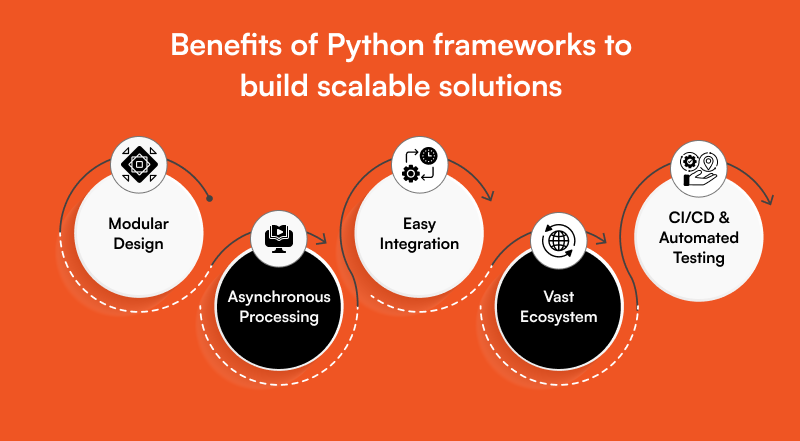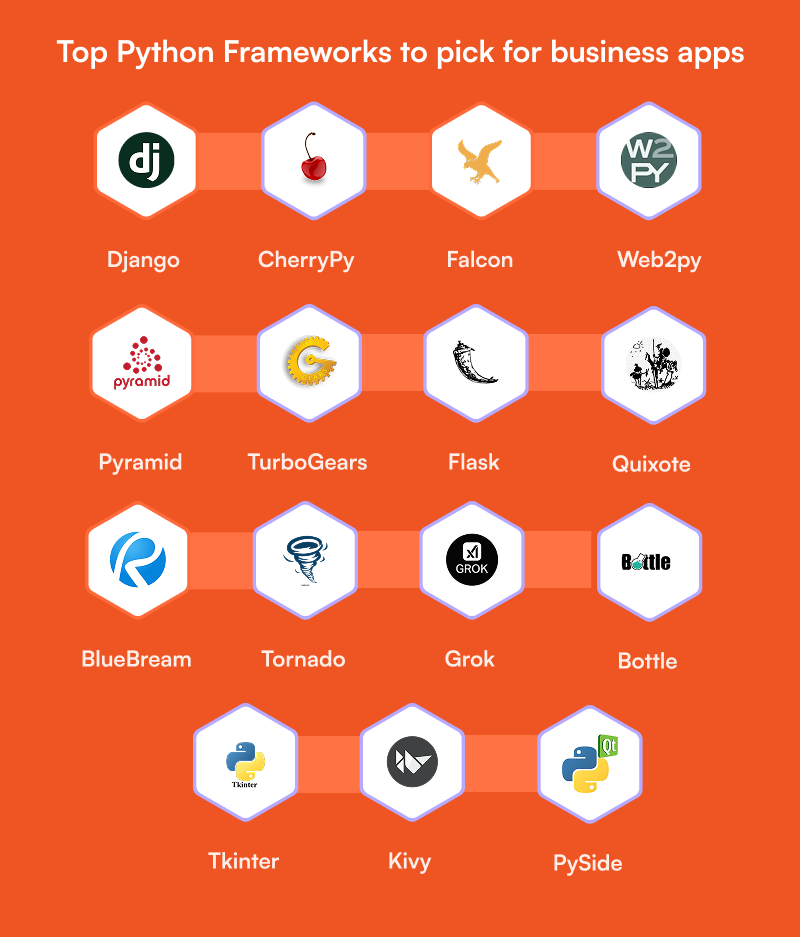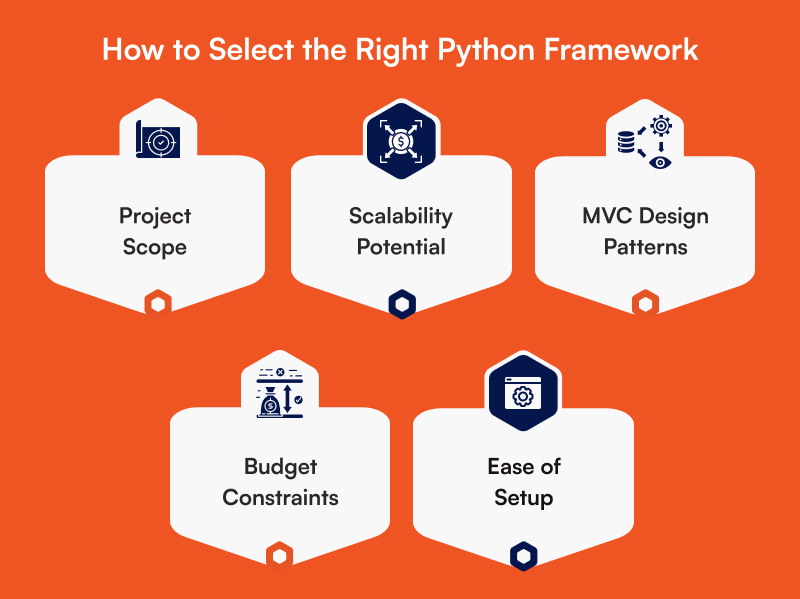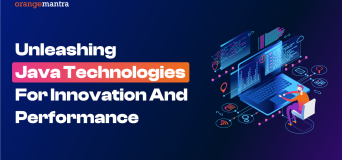
Here’s what you will learn:
Python’s popularity has remained high despite the emergence of dozens of similar development frameworks. It’s mainly because of the programming language’s continual evolution. Besides, Python frameworks provide developers with an efficient framework for building cutting-edge web apps and other solutions. These factors make Python development services a popular choice among diverse kinds of businesses. But what makes Python uniquely consistent and undeniably competitive?
Hire Python developers worldwide and rely on a set of frameworks to build their solutions. These frameworks play critical roles in keeping the Python programming language ahead in the rapidly transforming world of software development. In this blog post, we will discuss some of the most extensive 10 Python development frameworks. Read on to know how these frameworks keep improving Python web programming and related areas.
Table of Contents
What are Python frameworks?
Python frameworks are ready-to-use code libraries that make the app develpment process efficient. Developers use these frameworks to use pre-structured tools rather than creating each component from scratch. As, it speeds up development and minimizes human labor. Teams can now focus on innovation and product improvements.
When you hire Python developers, their attention changes to creating core functionality. Because frameworks handle routine features like database interactions and user authentication.
Benefits of Python frameworks for building scalable solutions
Here’s how Python web frameworks help B2B businesses.
· Modular Design
Microframeworks such as Flask and FastAPI facilitate the development of decoupled services. Because of their simplicity, developers create clear microservices that are simpler to grow and maintain.
· Asynchronous Processing
Asynchronous programming is supported by frameworks like FastAPI and Tornado. As, it let apps handle several requests at once. For systems with significan traffic that require non-blocking performance, this is crucial.
· Easy Integration
Databases, message queues, and APIs are all easily integrated with Python frameworks. Microservices can communicate across dispersed systems to maintain flexibility.
· Vast Ecosystem
Libraries for logging, monitoring, caching, and error tracking are available. So, Python development frameworks are essential for sustaining and growing distributed systems.
· CI/CD & Automated Testing
Python frameworks ensure dependable and scalable deployment procedures. As, it is easily integrated with CI/CD pipelines and testing libraries.
Top Python Web Development Frameworks to pick for business apps
Software engineers rely on a diverse range of Python web development frameworks to build their solutions using the Python coding language. These frameworks share considerable similarities and striking differences. Which one best suits your needs depend heavily on what kind of solutions you need to build.
1- Django
Django is an open-source, full-stack Python web development framework. It enables developers to write intricate code and build sophisticated web applications with less effort. Python developers widely use this framework for building feature-rich applications. It offers an array of libraries written in Python. Features of Django, like superior efficiency, code reusability, and less code, make it outstandingly popular across web developer communities.
The framework imposes an object-relational mapper to map instances to its database. It supports multiple popular databases, including MySQL, SQLite, and Oracle, among others. Besides, its supports also extend to web servers. With a battery of capabilities, Django web development is one of the most widely used categories for Python-based apps.
A few advantages to point out for Django.
- Django assists you in defining the exact URL pattern when you intend to develop the application
- Provides you with a simple yet effective URL scheme.
- It helps you integrate and adopt an authentication system.
Some improvement areas required for Django
- It has limitations for executing smaller kinds of projects.
- Django requires in-depth knowledge to use it in a smart way.
2- CherryPy
CherryPy, like Django, is an open-source Python framework for web programming. The framework is known for its exceptional speed and efficiency. It embeds its own multi-hung server, making the development process more efficient. CherryPy supports all development frameworks compatible with Python.
With CherryPy, you can use an extensive range of technology stacks for Python web development or related projects. Be it optimally accessing data, using templates, or creating advanced features, CherryPy helps you in every aspect of development. It also improves functional areas like monitoring sessions, uploading files, and managing cookies.
A few advantages to point out for CherryPy
- It is a thread-pooling WSGI webserver on which developers rely on
- It has an easy operation that works on different HTTP servers.
- Assists you in integrating the utilities for sessions, authentications, and encoding of static content.
Some improvement areas required for CherryPy
- The framework lacks proper documentation which sometimes gets difficult for people who are in their learning phase.
3- Falcon
Falcon is a minimalist web and probably one of the best Python frameworks for rapidly developing web APIs and app backends. Unlike other Python frameworks, Flacon enables you to build cleaner designs based on HTTP and REST API architectures. With Falcon, you don’t have to load a lot of dependencies for building HTTP APIs.
Flacon provides complete code coverage and is used by leading companies like LinkedIn and OpenStack. Some of the most prominent capabilities of Falcon include an optimized codebase, DRY request processing, speed boost, and idiomatic HTTP error responses, among others.
A few advantages to point out for Falcon
- Falcon is popular among developers for its lightning speed. The design of the framework allows better speed while answering all requests.
- This framework is widely accepted and incorporated by big market giants like LinkedIn and PayPal.
- Falcon works with a wide range of technologies such as WSGI and ASGI.
4- Web2py
Web2py is a cross-platform web application development framework written in Python. It’s open-source and enables developers to dynamic web content, among other capabilities. The framework offers a code editor, a debugger, and an array of other deployment tools. Web2py also features a ticketing system for promptly resolving any potential error.
The most noteworthy features of the Python web programming framework include cross-platform capabilities, seamless functionality without additional installation and configuration, multiple protocol-reading capabilities, the use of the model view controller (MVC) pattern, and many more.
A few advantages to point out for Web2Py
- It allows configuration while building web applications and increases the speed of web development.
- Enables the programmers with a NoSQL database.
- It helps you to maintain the safety of applications by addressing different security concerns.
Some improvement areas required for Web2Py
- System management gets tough while loading all other data models
- Python 3 support is missing.
5- Pyramid
Pyramid is one of the most flexible Python frameworks for web development. It runs on Python 3 and is widely used by experienced Python developers. Using the Pyramid framework, you can build basic web applications with a minimalistic approach. Tech-focused companies like Mozilla, Yelp, and SurveyMonkey use Pyramid.
Among the extensive array of services, the ones that you would love most include the ability to manage both small and large apps, URL mapping, HTML structure validation, comprehensive testing, and data documentation.
A few advantages to point out for Pyramid
- Assists programmers to work neatly on large as well as small applications.
- Helps in testing and extensive data documentation
- It provides you with authentication and authorization
Some improvement areas required for Pyramid
- The construction of complex, time-consuming tools is necessary for the Pyramid framework.
- Only skilled professionals can correctly install the Pyramid’s components.
6- TurboGears
TurboGears is completely a data-driven framework. It was developed with the intention to fill the gap or overcome the loopholes of several other frameworks which are used to build different web and mobile applications. It leverages mobile and backend developers to create applications using minimum setup. Developers can build the website swiftly by using the components like Repoze, SQLAlchemy, Genshi, and WebOb of TurboGears.
A few advantages to point out for TurboGears
- Almost every characteristic performs as a function decorator.
- It provides a multi-base kind of database
- Assists developers to explore command-line utilities
Some improvement areas required for TurboGears
- Some it gets difficult to enlarge the framework if required.
7- Flask
The Flask of Python web framework was invented by modeling the Sinatra Ruby tool. There is one toolkit and one template like Werkzeug WSGI and Jinja2. The Flask framework aims to support the development of a strong web app base.
A few advantages to point out for Flask
- Built-in development is possible with a debugger in the case of Flask.
- It helps programmers to use Jinja2 templating
- In this framework, there is a chance for an integrated support system for unit testing.
Some improvement areas required for Flask
- To use this framework, high efficiency is required for developers. Better attention is needed for detailing to understand the detailing.
8- Quixote
Python programmers can easily develop web-based applications by using the Quixote framework. Quixote aims to increase efficiency in terms of overall performance and flexibility while developing the web application. Quixote framework assists developers in experimenting and learning “real programming language.”
A few advantages to point out for Quixote
- It is simple and flexible to use during the designing web page
- There is a huge library of various functionalities available for analyzing an HTML form.
- In this framework, developers will get the support SCGI protocol
9- BlueBream
BlueBream is one of the best open-source frameworks for developing web applications. This framework serves at its best for large as well as medium-sized tasks. These works are divided into various other user segments. BlueBream offers good experiences to the developers which satisfies them by meeting their key requirements for persistent and durable programming.
A few advantages to point out for BlueBream
- BlueBream is required for functional testing.
- In this framework, a language complaint is required for developing templates with XHTML.
- It is also used as a tool for generating forms automatically.
Some improvement areas required for BlueBream
- It requires in-depth learning if the developers are gaining knowledge about Python for the first time.
- It is sometimes difficult in terms of its utility, specifically for simple and moderate tasks.
10- Tornado
The Tornado framework is kind of unconventional compared to others. Tornado helps developers to solve the issue of C10k. This means the framework is able to handle almost nearly 10k connections with its available configuration. Because of its ability makes the best tools for building different applications to satisfy business needs.
A few advantages to point out for Tornado
- An authorization mechanism is required for this framework, it enables developers with third-party authentication.
- It showcases real-time services, and better quality that never blocks the development process.
- This framework allows you in fetching high-quality results.
- It assists with web templates and user authentication.
11- Grok
Overview:
Grok is a Python web framework designed for developers that is based on the robust Zope Toolkit (ZTK). By adopting the ideas of Don’t Repeat Yourself (DRY) and Convention over Configuration. As it
streamlines the creation of complicated applications. Grok allows developers to create complex, enterprise-grade online apps. That too without being constrained by complicated setups or repeating boilerplate.
Advantages:
· Built on Zope 3, allowing for component-based and modular development.
· Includes a strong object database (ZODB) integration for processing data over time.
· Geared toward agile iterations and quick prototyping.
· Granular security control with integrated authorization systems.
12- Bottle
Overview:
Bottle is a single-file, minimalist Python frameworks that is ideal for rapid prototyping. Bottle offers a lightweight approach to developing online applications. While providing routing, templating, and request handling right out of the box. All without the need for other dependencies outside of the Python Standard Library.
Advantages:
· Zero dependence footprint—perfect for standalone installations and embedded systems.
· Code that is legible and maintainable is encouraged by clear, simple syntax.
· Support for many WSGI servers, including Paste, Gunicorn, and fapws3, as well as an integrated development server.
· Smooth management of uploads, headers, cookies, and forms.
13- Tkinter
Overview:
Python’s built-in GUI library, Tkinter, provides a simple method for creating graphical desktop applications. It is perfect for quickly creating small tools or instructional apps utilizing simple UI element. Because it comes with Python and doesn’t require any further installations.
Advantages:
· Easy to set up, this is a part of Python’s standard library.
· Creates interfaces that look natural by using the Tk GUI toolkit.
· Interoperability between Linux, Windows, and macOS.
· Perfect for novice programmers who wish to experiment with GUI development.
14- Kivy
Overview:
An open-source Python framework called Kivy is used to create cross-platform, multi-touch apps. Its primary advantage is that it provides a single codebase for desktop and mobile apps. Kivy is very popular for artistic projects, graphical user interfaces, and interactive applications.
Advantages:
· Multiple form factors and operating systems are supported by the same codebase.
· MIT-licensed—perfect for open-source and commercial enterprises.
· Includes integrated support for graphics, animations, and gesture recognition.
· Maintains a uniform appearance across platforms by not depending on native UI toolkits.
15- PySide
Overview:
The Qt Company created and supports PySide, a fully functional Python wrapper for the Qt framework. It allows developers to create stable and well-designed cross-platform desktop programs, much like
PyQt, but it has the added flexibility of LGPL licensing, which makes it better suited for proprietary software development.
Advantages:
· Good for commercial applications without complicated licensing, licensed under the LGPL.
· Uses Qt’s sophisticated rendering engine to provide rich user interfaces and native performance.
· Supports event-driven and multi-threaded architecture for responsive apps.
· Allows sophisticated UI elements, custom widgets, and multimedia material for seamless integration.
How to Select the Right Python Framework
Here are some pointers to choosing the Python frameworks.
Project Scope
Full-stack frameworks like Django are the best choice for large, feature-rich apps. Microframeworks like Bottle or FastAPI are more appropriate if you’re creating a prototype.
Scalability Potential
Make sure the framework you’ve selected can grow both vertically and horizontally. For apps that anticipate spikes in traffic or quick expansion, this is essential.
MVC Design Patterns
The majority of frameworks adhere to the Model-View-Controller (MVC) desig. It encourages maintainability and code separation. Other structures, like as MVP, MVVM, or MVA, might be more advantageous for specific projects. Therefore choose which one best suits your architecture.
Budget Constraints
While dedicated servers hosting may provide superior performance. However, they may also put a strain on smaller budgets. The available hosting environments support may also have an impact on the Python web frameworks selection.
Ease of Setup
Development time and server configuration problems are decreased by a framework. As, with a more seamless deployment and installation process. Startups and small teams particularly benefit from setup simplicity.
Real-world use cases of Python Web Development Frameworks across industries
Technology
Startups may iterate and launch concepts more quickly. Because of Python’s understandable syntax and speedy development cycle.
Ecommerce
Microservices make it possible for high-demand components. Such as payment gateways and product searches, to scale independently. It is essential during times of heavy traffic or sales.
Fintech
Sensitive financial data processing and regulatory requirements needs security. As, the Python frameworks offer secure, scalable, and compliant microservices architecture.
Healthcare
Microservices in healthcare and medical technology facilitate the management of intricate, real-time data from various sources, including diagnostic platforms and patient monitoring systems.
Concluding Thoughts
Python framework is incredibly easy to learn. And that’s perhaps the single most striking factor that makes the language so popular among beginners and experienced developers alike. With Python, developers can integrate an extensive range of features and functionalities with unmatched speed and seamlessness. Besides, Python’s evolution per the changing market needs keeps it from getting behind in the race.
At OrangeMantra, our web application developers love to use Python for making advanced web solutions. Being a trusted Python web development company, we proactively upgrade our methods and frameworks.
FAQs
1- What is the most popular Python framework?
Django is still one of the most popular Python web frameworks for several reasons, including Wide-ranging functionality. Django’s “batteries included” strategy includes pre-installed functionality, including session management, data validation, caching, and authentication.
2- What function do Python frameworks serve?
These frameworks facilitate development by automating repetitive operations to cut down on development time. They enable developers to devote more of their attention to the logic of the program.
3- What is the most popular Python framework?
Django remains a leading Python web framework because it delivers wide functionality out of the box. Its batteries-included approach covers session handling, data validation, caching, and authentication from day one. This makes it a strong fit for web development services that need reliable features without adding extra tools.
4- What is the main benefit of using frameworks for programming?
All things considered, a framework can assist in expediting the development process, improve the code’s maintainability and reusability, and guarantee that the software is created in accordance with industry standards and best practices.
5- What is the price of a Python program?
Since Python is an open-source programming language, you can use it for free and get its frameworks and libraries without paying a dime. Additionally, Python may be used with free IDEs and code editors such as Visual Studio Code (vs.), PyCharm, and Atom.







